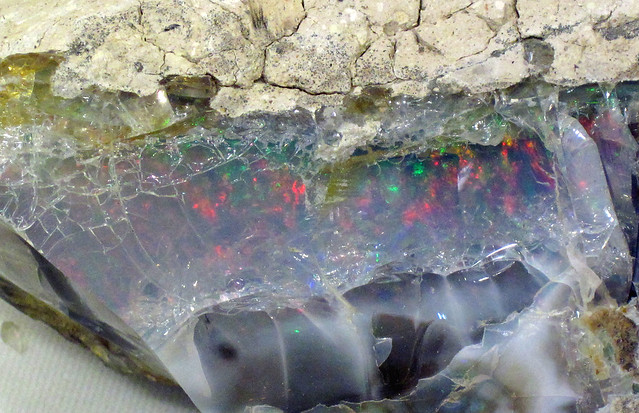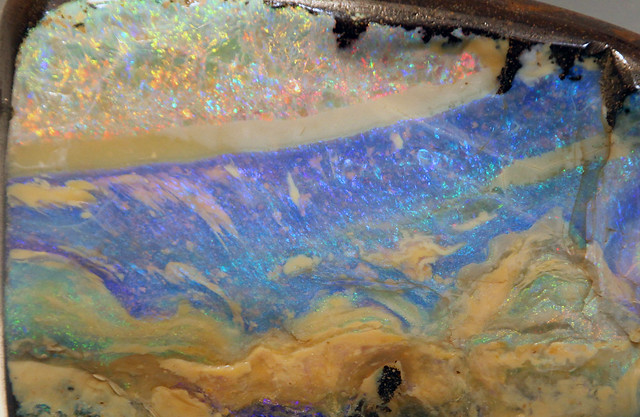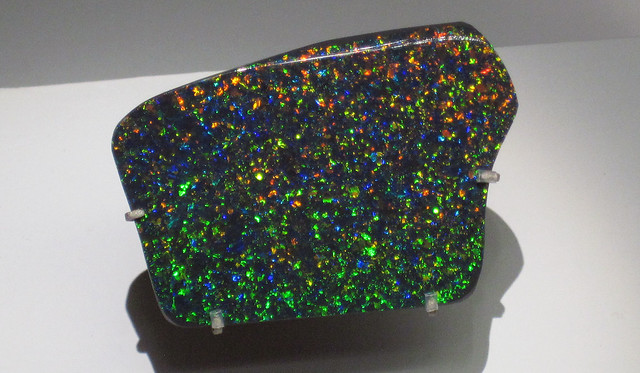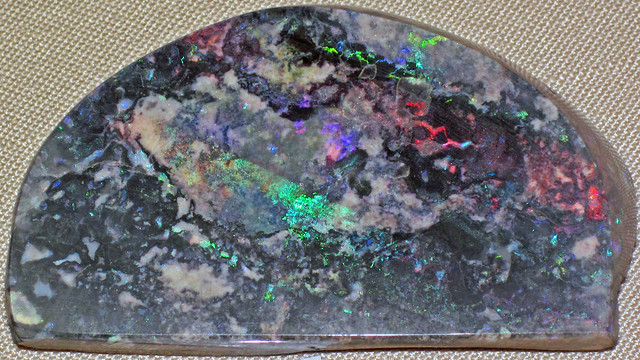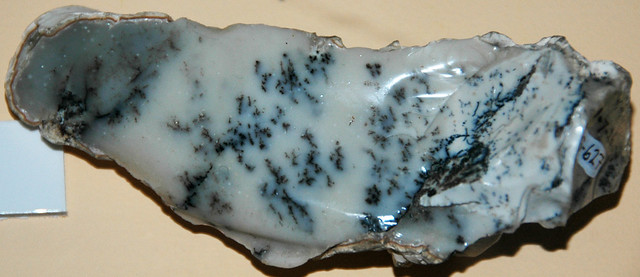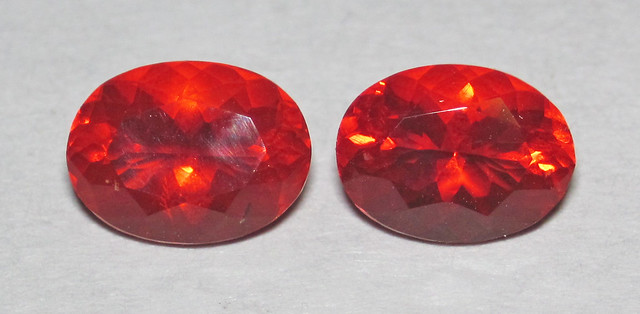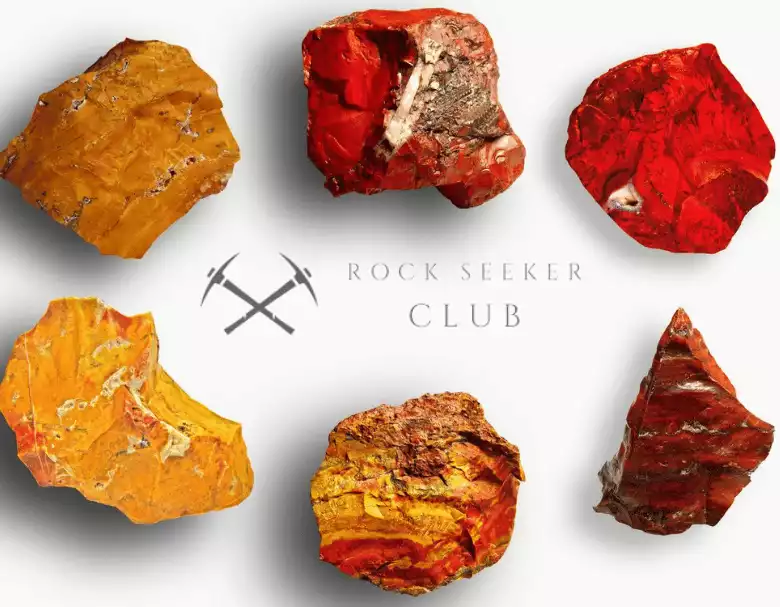There are many different kinds of opal out there, far more than most people realize. Each has its own individual charm, whether it’s the colorful common opal found in the deserts of Nevada or the incredibly beautiful black opal that comes from the Lightning Ridge area in Australia.
So, let’s expand our knowledge and take a look at some of the many kinds of opals, with helpful pictures to guide you along!
1. Australian Opal
Australia is famous for its opal fields. Indeed, for much of modern history, Australia was the only place churning out large quantities of gem-grade opal. The opal from Australia is generally much more stable than that found in other locations, which is a huge bonus for those who cut them. Even today, with cheaper alternatives readily available, Australian material commands a premium.
For the most part, Australian opal is non-hydrophane. Hydrophane opals are hydrophilic and prone to beginning to craze on the exterior as the nodules dry out. Solid opal is a different beast altogether, with much of it being able to be cut without fear of the gemstone destroying itself over the ensuing months.
The opal from Australia still makes up 95% or more of the trade in precious opal, especially at the higher ends of the market. It’s found in classic jewelry pieces including in cheaper forms like doublets and triplets. Much of it has a white body color, which has become the hallmark of the stone in many places. Opals from other places will tend to have different bodies.
2. Welo Opal
Welo opal is a bit of a newcomer to the scene and is the main variety of opal that comes out of Ethiopia. It’s generally a hydrophane opal, often with high transparency and occasionally with a slight orange tint to the body color. Fewer are white or darker in color.
For a collector, such as myself, these are the most easily accessible varieties of precious opal. They’re much cheaper than their Australian cousins, even in the same grade, and large pieces can be had for just a few hundred dollars. Smaller stones are cheap and readily available, with more coming onto the market each day.
Welo opal can be a bit unstable. It’s important to note your source if you’re buying finished gemstones, as material that’s been cut before being tried has a tendency to craze. They should also be kept out of water, so make sure you remove your favorite ring or necklace before you hop in the shower.
3. Boulder Opal
credit: Tony Hisgett
Boulder opal is another of the distinctive types of opal that comes out of Australia. In this case, the material is thin precious opal that’s sandwiched in matrix, giving a mottled appearance. The best of these are largely opal, with stripes of the bedrock intermixed, but some of the material isn’t quite as pretty.
The stone they’re encased in is ironstone. Ironstone itself is a ferric sedimentary stone, but it has a relatively high hardness at 5-5.5 on the Moh’s scale. This aligns almost perfectly as opal, making it possible for great cabochons and carvings to come with the matrix included.
Boulder opal is cool stuff and a bit of a freak in nature. The hardness of the matrix means that the small amounts of precious opal contained in the cracks, fissures, and voids of the stone can be used as-is. The fate of most opal this small and thin is as inlay or doublets, but this oddity is best enjoyed in situ.
4. Black Opal
Perhaps the most famous gem opal is black opal. The material comes primarily from Lightning Ridge in New South Wales. The difference between black opal and opal from other regions is in the body color, which is black of course. This black body gives the stones an otherworldly appearance, however, and it makes the colors stand out even more.
Black opal is vanishingly rare and extremely expensive, particularly the Australian kind. There are a few other places where black opal is occasionally found, however, including Nevada. Most of the specimens from these regions aren’t quite of the same quality. Most of it is display-grade only, and even then it should be stored in water.
There is one thing to be aware of with black opal: Welo opals can be smoke-treated or acid-treated to darken the background color. If you’ve held both treated stones and black opal before it’s easy to recognize the difference, but if a deal looks too good to be true or it’s being sold as Ethiopian black opal with no other proof, then you should probably hold on to your money.
5. Matrix Opal
Matrix opal is similar to boulder opal with some key differences. As a general rule it only comes from the Australian fields, but there’s one other location we’ll discuss shortly. While boulder opal bears “large” pieces of opal in ironstone, the ironstone of matrix opal is interspersed with much smaller particles. This leads to a stone that looks like the matrix, but also flashes with color.
There is a similar type of opal that’s found only in Louisiana, although it’s thought to be mined out. Louisiana sandstone opal is almost the same, just with sandstone instead of the usual ironstone. While quite rare these days, they’re not as valuable as many other types of opal and the sandstone lacks enough iron to be exceptionally stable like the Australian variety.
The most common source of this material is the Andamooka field. Andamooka matrix opals can be very bright, with a lot of granular color spread throughout the stone. Pricing on the material varies widely, but it’s attainable for a gem collector who really wants some if they’re willing to forgo the highest grades.
6. Dendritic Opal
Dendritic opal can be found in many places, but it always has the same configuration. It’s a milky, semi-transparent white with black dendrites growing inside of it. Some of these are intermixed with harder, and more transparent, agate which leads to a lot of confusion between dendritic agate and opal. The distinction is pretty fine, admittedly.
The dendrites in these opals usually resemble trees or ferns. The material is almost uniformly white, although there are some off-white instances I’ve seen. While this is common opal, it’s still an amazing stone to have around. It’s also fairly easy to work if you’re near an area that has some, just don’t let the material get too hot.
The namesake dendrites in this opal variety are actually inclusions of metallic oxides. These are generally iron oxide or manganese oxide. It can also be found by the name “merlinite” when you’re looking for it, so bear that in mind if you’d like to add a couple of cheap pieces of opal to your collection.
7. Fire Opal
Fire opal is almost exclusively found in Mexico and Oregon. It’s a highly transparent, common opal variety that ranges from light yellow to deep red. All the colors of a fire, in other words. Most of the good material is cut into gemstones, where the milkiness of the opal and the bright colors give them their other name, “jelly opals.”
The material was almost universally referred to as “Mexican fire opal” until recently, regardless of where it originated. These days, Mexican material can still be found, and there’s a higher incidence of precious opal from those fields. The name is also used for the next one on our list, the cantera opal.
Fire opal is a very valuable stone, and worth every penny for those who love warm tones. It’s still a good idea to be careful using this kind of opal in rings or bracelets, as they’re just as fragile as any other opal but more often cut into standard gemstone configurations. The precious variety is very rare and very expensive, but it can be found for those who are willing to dig deep enough.
8. Cantera Opal
Cantera opals are a specific type of opal unique to Mexico. These opals are housed in rhyolite, often in thick bunches. At times, stones are cut from the rhyolite, at least when it’s stable enough for cutting and polishing. While there are some fakes out there, these are common enough in nature that even the real ones aren’t wallet breakers.
Cantera opals can be found in a couple of forms. The most common configuration is a single large “bean” of opal centered with a bit of rhyolite left around the exterior edges. Other times, you’ll find cabochons cut with multiple opals in the same piece, giving a strange effect.
The best form, in my opinion, is the carvings that use the opal to their advantage. I’ve seen skulls with an opal “third eye” and detailed animal figurines made from the material. The reason for the round shape is simple: they formed in voids left in the host rhyolite during formation by bubbles.
9. Madagascar Green Opal
Perhaps the most common and accessible opal to be found online, Madagascar has large amounts of a green common opal that’s become a favorite of rockhounds. It takes the form of an olive green opal, with slight mottling of different shades. This mottling isn’t extreme and sometimes doesn’t appear until the final sanding and polishing are applied.
While accessible and dirt cheap, these opals have a tendency to break apart. It’s a favorite carving material of mine, but perhaps 2-3 1”-2” rocks in a bag of 15 are suitable for carving. Most of these will be readily apparent, you can break them apart with your hands, but on occasion, a deep fracture will result in a workpiece breaking.
Rarely seen is the higher grade material. This is a darker green opal which tends to have a bit of translucency and is often quite a bit more stable than the rest of the material. But if it’s an opal you’re looking to add to your collection, it’s hard to beat the price of this opal which is pennies per carat in the rough form.
10. Peruvian Common Opal
Another common, and beautiful, opal that’s been making the rounds is the Peruvian common opal. There are two main colors found, blue and pink, both of which are readily available to collectors. The lower grades of the material tend to remain stable, which makes it a good choice for those who want to cab or carve.
Higher-grade blue opal gets an intense sky-blue color, and it’s often interlaced with dendrites. This high-end material isn’t cheap, a few bits of rough will run you a few hundred dollars, but it’s stable and can be turned into beautiful gemstones with a light touch. Pink material also bears dendrites on occasion but is generally a much cheaper stone overall.
These make another great entry-grade opal for collectors. While the pink stuff is almost always cheap, there are several grades of blue material. At the bottom end is light blue and white common opal which is entirely opaque, while the upper end of the scale brings an almost neon blue and translucent material that’s shocking dramatic even in rough form.
- Online rock and mineral club for collectors of all levels!
- Find community with like-minded rock and mineral enthusiasts.
- Monthly Giveaways!
- Free Access to Entire Digital Library of Products (annual memberships)


